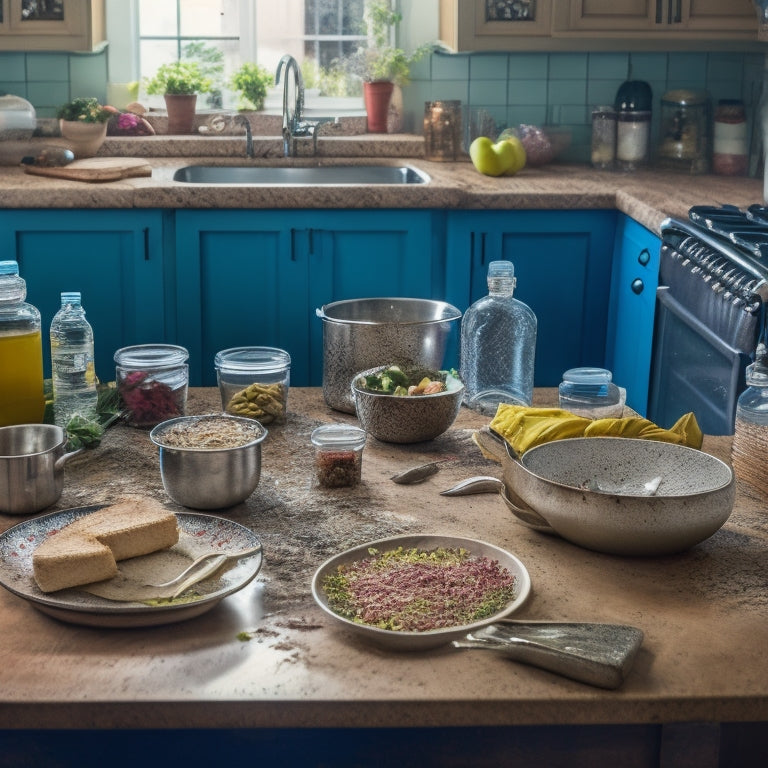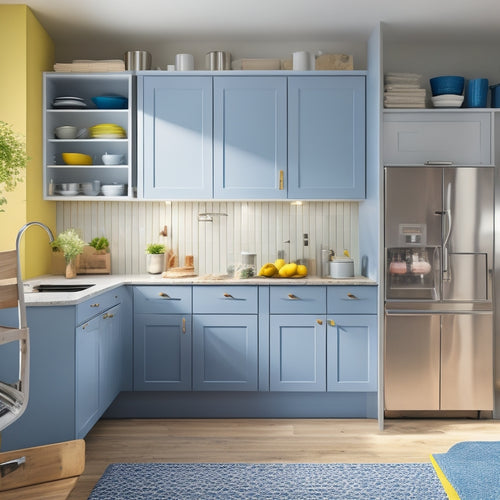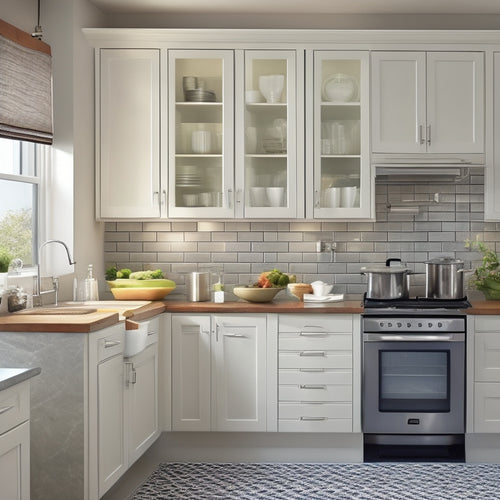
What's Holding You Back From a Clutter-Free Kitchen?
Share
You're likely stuck in a cluttered kitchen because you haven't cleared off your counters, sorted items, and assigned a home for each. Your cabinets are inefficiently used, and you're not maximizing vertical storage. The sink area is cluttered, and utensils are scattered everywhere. Your pantry shelves are underutilized, and bulky appliances are taking up valuable space. By addressing these areas, you can create a more organized, functional kitchen. To gain control over the chaos, identify the specific areas holding you back and start implementing changes - and you'll be one step closer to a kitchen that sparks joy and inspires creativity.
Key Takeaways
• Failure to categorize and purge unnecessary items leads to clutter accumulation on kitchen counters.
• Inadequate cabinet storage and organization result in cluttered countertops and wasted space.
• Inefficient use of vertical storage solutions, such as shelves and hooks, contributes to cluttered countertops.
• Poor utensil organization and storage lead to cluttered drawers and countertops.
• Ineffective pantry shelf space management and lack of dividers and labels hinder a clutter-free kitchen.
Decluttering Your Kitchen Counters
Start by clearing everything off your kitchen counters and sorting items into categories, such as baking supplies, coffee station essentials, and frequently used appliances. This will give you a clear view of what you're working with and help you identify areas where Countertop Clutter is building up. Be honest with yourself - do you really need three toasters or can you get by with just one?
As you sort, get rid of anything broken, expired, or no longer useful. You'll be surprised at how quickly Kitchen Chaos can dissipate when you eliminate unnecessary items.
Next, assign a home for each category of items. This means designating a specific spot for your coffee maker, utensils, and other frequently used items. This will help keep your countertops clear and make it easier to find what you need when you need it.
Maximizing Cabinet Storage Space
You can greatly increase your kitchen's storage capacity by optimizing the use of your cabinets, which often become cluttered with items that are difficult to access or forgotten altogether. By implementing a few simple strategies, you can turn your cabinets into efficient storage spaces that make your life easier.
Start by installing cabinet dividers to separate items into categories, making it simpler to find what you need when you need it. This will also prevent clutter from building up in the future.
Next, add shelf liners to protect your shelves from spills and stains, making cleaning a breeze. Consider investing in adjustable shelves or baskets to maximize vertical space and keep items off the floor.
Utilizing Vertical Storage Options
Take advantage of your kitchen's often-wasted vertical space by incorporating wall-mounted shelves, hooks, and racks that keep frequently used items within easy reach. This won't only free up counter space but also make cooking and prep work more efficient.
You can install wall shelves to store cookbooks, spices, or infrequently used kitchen gadgets, keeping them organized and out of the way. Consider adding ceiling racks to hang pots, pans, or utensils, making them easily accessible while keeping your countertops clear.
Streamlining Your Sink Area
When you're washing dishes, you don't want to be surrounded by clutter. By streamlining your sink area, you'll be able to focus on the task at hand and make the process more efficient.
You'll learn how to banish soap scum and keep essential items within easy reach, making this high-traffic area a breeze to navigate.
Soap Scum Solutions Found
Soap scum buildup around your sink area can be banished with the right cleaning tools and a few simple habits. By incorporating these strategies into your daily routine, you'll be saying goodbye to that pesky soap scum in no time.
Here are some effective soap scum solutions to get you started:
-
Clean as you go: Wipe down the sink and faucet after each use to prevent soap scum from building up.
-
Use a soap scum prevention spray: These sprays can be applied to the sink and faucet after cleaning to repel soap scum and water spots.
-
Make a natural cleaning paste: Mix baking soda and water to create a paste that can be applied to the sink and faucet to remove soap scum and stains.
-
Use a microfiber cloth: These cloths are gentle on surfaces yet effective at removing soap scum and water spots.
-
Incorporate shower cleaning hacks: Clean your shower walls and door with a squeegee or microfiber cloth after each use to prevent soap scum from building up.
Essential Items Within Reach
Essential Items Within Reach
Keep your most frequently used sink-area essentials, like dish soap, hand soap, and scrubbers, within easy reach by designating a specific spot near the sink for these must-haves. This handy zone will streamline your kitchen workflow, saving you time and effort in the long run. By keeping essentials within arm's reach, you'll avoid cluttering your countertops and reduce the likelihood of spills and messes.
Designate a specific spot, such as a built-in soap dispenser or a small tray, to corral these essentials. This will create a sense of order and belonging in your kitchen. You'll appreciate the convenience of having what you need exactly where you need it, making meal prep and cleanup a breeze.
A clutter-free sink area also sets the tone for a more organized kitchen, promoting a sense of calm and control. By implementing this simple yet effective strategy, you'll be well on your way to a more efficient, stress-free kitchen.
Organizing Kitchen Utensils Effectively
You'll be amazed at how efficiently you can cook and prepare meals once you've organized your kitchen utensils, freeing up counter and storage space in the process. A cluttered kitchen can be overwhelming, but with a few simple strategies, you can create a space that's functional and enjoyable to use.
To get started, implement Utensil Rotation by storing your most frequently used utensils in easy-to-reach locations. This will save you time and effort in the long run.
Next, practice Utensil Categorization by grouping similar items together, such as all your baking utensils or cooking tools. This will make it easier to find what you need when you need it.
Here are some additional tips to help you organize your kitchen utensils effectively:
-
Designate a specific drawer or container for each category of utensils
-
Use dividers or inserts to separate items within a drawer or container
-
Hang frequently used utensils, such as pots and pans, on a pegboard or hooks
-
Store infrequently used items, such as special occasion dishes, in harder-to-reach areas
-
Clean and maintain your utensils regularly to prevent clutter from building up again
Creating a Functional Pantry
As you tackle the task of creating a functional pantry, you'll need to start by identifying what's essential to keep and what can go.
You'll then want to implement a pantry organization system that works for you, whether that's baskets, bins, or shelves.
Pantry Purge Essentials
To create a functional pantry, start by gathering supplies like sturdy storage bins, stackable shelves, and a label maker to help you categorize and contain your food items. These essentials will enable you to organize your pantry efficiently, reducing food waste and making meal planning a breeze.
Before you begin, take everything out of your pantry and sort items into categories, such as grains, canned goods, and snacks. Then, use your supplies to create a system that works for you.
Here are some pantry purge essentials for your consideration:
- A 'first in, first out' shelf for perishable items
- Airtight containers for storing dry goods
- A designated zone for meal prep ingredients
- A basket for storing snacks and treats
- A label maker for identifying contents and expiration dates
Pantry Organization Systems
By dividing your pantry into zones and assigning a home for each type of food, you create a functional pantry that streamlines meal prep and reduces clutter. This system allows you to categorize similar items together, making it easier to find what you need when you need it.
For instance, designate a zone for baking supplies, another for canned goods, and a third for snacks. Within each zone, use shelf dividers to separate items further, keeping similar products in their own 'neighborhood.' This structure helps maintain organization and prevents clutter from building up again.
To take your pantry organization to the next level, consider the frequency of use and storage requirements for each item. Store heavy or bulky items at the bottom, and lighter or less frequently used items towards the top. Reserve the most accessible shelves for your most-used items, making meal prep a breeze.
Maximizing Shelf Space
You can optimize your pantry's shelf space by installing adjustable shelves, baskets, or bins that fit snugly together, allowing you to make the most of every inch. This will help you store more items in a smaller area, keeping your pantry organized and clutter-free.
Here are some additional tips to maximize your shelf space:
-
Use shelf dividers to separate items and prevent them from getting jumbled together
-
Install shelf labels to easily identify what's stored on each shelf
-
Store heavy items at the bottom to prevent them from falling and causing a mess
-
Utilize the back of the pantry door by installing a spice rack or a storage bin
-
Keep frequently used items at eye level to make them easily accessible
Hiding Kitchen Appliances Neatly
Your kitchen countertops can remain clutter-free by cleverly concealing bulky appliances, such as stand mixers and toaster ovens, in strategically designed cabinets and alcoves. This not only frees up space but also creates a more streamlined look.
Here are some clever ways to hide your kitchen appliances:
| Appliance Hiding Spot | Description |
| Appliance Garages | Built-in cabinets with doors or tambour panels that slide open to reveal appliances |
| Hidden Corners | Custom-designed corner cabinets that rotate or slide out to access appliances |
| Pull-Out Shelves | Adjustable shelves that slide out to reveal appliances, making them easy to access |
| Lift-Up Cabinets | Cabinets with lift-up doors that conceal appliances, ideal for infrequently used items |
| Drawer Inserts | Custom-designed drawer inserts that hold small appliances, keeping them out of sight |
Frequently Asked Questions
How Do I Maintain My Clutter-Free Kitchen Over Time?
To maintain your clutter-free kitchen, you'll establish daily habits like wiping down counters and putting away dishes, and schedule regular maintenance routines, like monthly deep cleans, to keep your space organized and peaceful.
What if I Have Limited Kitchen Renovation Budget?
"You're willing to splurge on avocado toast, but a kitchen renovation is too pricey? Get real, friend! Create a Budget Breakdown and prioritize Cost Cutting measures to achieve your clutter-free kitchen dreams without breaking the bank."
Can I Repurpose Old Kitchen Items to Save Money?
You can breathe new life into old kitchen items! Get creative with upcycles, like turning mason jars into utensil holders or old cutting boards into decorative wall art, to save money and add unique kitchen hacks to your space.
How Do I Involve My Family in Kitchen Decluttering Process?
You involve your family in kitchen decluttering by assigning kitchen roles, sparking family motivation; let each member own a task, and celebrate their progress, fostering a sense of teamwork and belonging.
Are There Any Eco-Friendly Kitchen Organization Products Available?
"Seeking sustainable solutions, you'll find fantastic finds in eco-friendly kitchen organization products. Opt for options made from Sustainable Materials, embracing Green Alternatives that align with your values, and create a clutter-free kitchen that's both functional and environmentally friendly."
Related Posts
-

Smart Storage Solutions for Small Kitchen Spaces
You're struggling to find space in your small kitchen, but don't worry, smart storage solutions can help. Start by ut...
-

Community Engagement: Learning Through Professions
Community engagement is a powerful tool for fostering a deeper understanding of various professions among children. B...
-

Boost Kitchen Cabinet Storage With Lid Racks
You're looking to boost your kitchen cabinet storage with lid racks. By incorporating lid racks, you'll free up valua...


